
Gender Expression VS Gender Identity, The Nuances
Gender identity and gender expression are two concepts that are often confused or used interchangeably, but they are distinct and separate aspects of an individual’s identity.
Gender identity refers to a person’s inner sense of being female, male, a combination of both, or neither. It is a deeply felt and inherent aspect of a person’s sense of self, and it may or may not align with the gender assigned to them at birth.
On the other hand, gender expression refers to the way a person presents their gender to the world through their behavior, clothing, hairstyle, and other forms of self-expression. It can be masculine, feminine, androgynous, or any combination of these.
On this page
Importance of Understanding the Difference Between the Two
Understanding the difference between gender identity and gender expression is crucial for creating a more inclusive and accepting society. People who do not fit into the traditional binary gender categories of male and female may experience discrimination, harassment, and marginalization.

By recognizing and respecting individuals’ gender identities and expressions, we can create a more affirming environment that values gender diversity and promotes equality. This can have a positive impact on the mental health and well-being of individuals who may have previously felt invalidated and marginalized by society.
What is Gender Identity
Gender identity is a deeply held sense of one’s own gender, which may or may not correspond with the gender assigned at birth. It is a personal and internal experience of gender, and it can vary widely from person to person.

Examples of Gender Identities
Gender identities can include but are not limited to:
- Male
- Female
- Non-binary
- Genderqueer
- Agender
- and Genderfluid
Some individuals may also identify as a combination of these or other gender identities.
How Gender Identity develops
Gender identity development is a complex and multifaceted process that begins in early childhood and continues throughout one’s life. It is influenced by a variety of factors, including biology, culture, socialization, and personal experience.
Differences between Gender Identity and Gender Assigned at Birth
Gender identity is distinct from the gender assigned at birth, which is typically determined based on physical characteristics such as anatomy. While assigned gender at birth is typically seen as a binary between male and female, gender identity can encompass a broader spectrum of identities and expressions.
Understanding Gender Dysphoria
Some individuals may experience gender dysphoria, a medical condition in which a person experiences distress or discomfort due to a mismatch between their gender identity and the gender assigned to them at birth. Treatment for gender dysphoria can include gender-affirming hormone therapy, surgery, and therapy.
What is Gender Expression
Gender expression definition can be told in many ways but to put it simply, it refers to the way individuals express their gender identity through external factors such as:
- Clothing
- Grooming and
- Behavior

It is a visible and outward manifestation of one’s internal sense of gender.
Examples of Gender Expressions
Gender expressions can include but are not limited to:
- Masculine
- Feminine
- Androgynous and
- Gender-neutral
Clothing choices, hairstyle, makeup, and body language are all examples of how someone might express their gender.
How Gender Expression can vary
Gender expression can vary widely from person to person and can change over time. Some individuals may have a more fluid expression of gender, while others may have a more fixed expression.
The ways in which individuals express their gender are influenced by a variety of factors, including culture, personal preference, and social norms.
Understanding Gender Non-conformity
Gender non-conformity refers to individuals who do not conform to traditional gender norms or stereotypes. This can include individuals who identify as non-binary or genderqueer, as well as those who identify as male or female but express their gender in non-traditional ways.
Gender non-conforming individuals may experience discrimination and marginalization due to their non-conformity.
Gender Identity VS Gender Expression Differences, Explained
While gender identity and gender expression are closely related, they are distinct concepts. Gender identity refers to an individual’s internal sense of their gender, while gender expression refers to the external manifestation of that gender.

In other words, gender identity is who a person is, while gender expression is how they show it to the world.
Examples of How Gender Identity and Gender Expression can Differ
An individual’s gender identity may not always align with their gender expression. For example, a person who identifies as female may express their gender in a more masculine way, or vice versa.
This can be seen in the way that some people may have a gender identity that is different from the gender typically associated with their assigned gender at birth, but express their gender in a more traditional way.
Importance of Recognizing and Respecting Individuals’ Gender Identities and Expressions
Gender identity and expression are fundamental aspects of a person’s identity, and denying or invalidating these aspects of a person can have serious negative effects on their mental health and well-being.
By understanding the difference between gender identity and gender expression, we can create a more affirming environment that values gender diversity and promotes equality.
Furthermore, it is important to note that gender identity and gender expression are not determined by any one factor, such as biology or culture. Rather, they are influenced by a complex interplay of biological, social, and cultural factors.
As a result, gender identity and expression are highly individualized, and it is important to recognize and respect the unique experiences of each individual.
Intersectionality of Gender Identity and Gender Expression
Gender identity and gender expression intersect in complex ways, and it is important to understand how these concepts interact. For example, an individual who identifies as non-binary may express their gender in a way that is a combination of masculine and feminine elements, or may choose to present their gender in a gender-neutral way.
By recognizing and respecting the intersection of gender identity and gender expression, we can create a more inclusive environment that values the diversity of gender experiences.
Legal and Social Implications of Gender Identity and Expression
Gender identity and expression can have significant legal and social implications, particularly for individuals who identify as transgender or gender non-conforming.
Discrimination and harassment based on gender identity and expression are prohibited in many countries, but these protections are not universal. Additionally, individuals may face challenges accessing healthcare or navigating legal systems due to their gender identity and expression.
It is important to advocate for legal and social protections for all individuals, regardless of their gender identity or expression.
In conclusion, recognizing and respecting individuals’ gender identities and expressions is crucial for creating a more inclusive and accepting society.
Feel free to share this guide on your timeline to spread awareness. You may also join the conversation by commenting below.



